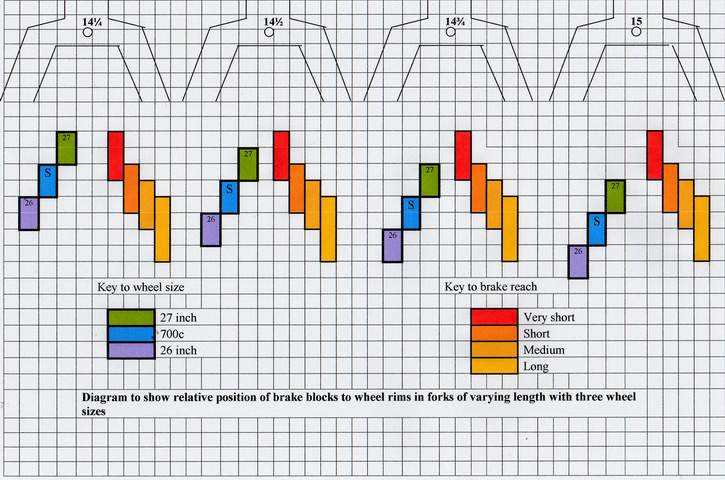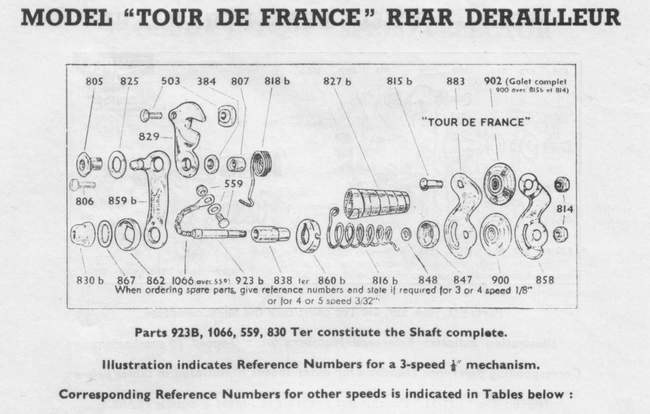A method to choose brake sets and wheel size to fit varying fork lengths
Posted: Monday 21st September 2020
Have you ever spent hours fitting wheels and brake sets to an itinerant frame that only wants to hang on a wall somewhere – and then found the ones that fit are either not in period or you only have one of that sort? This method with its table and diagram may help you to plan your bike:
Many bicycle restorers face the problem with newly acquired frame sets of which wheel size and which brake set to use to physically fit the frame, which might have been built with close tolerance for sprints or perhaps for 26 inch or 27 inch (even in earlier frames for 28 inch) wheels, with or without mudguard clearance. Leaving aside for the moment the problem of keeping the brake set in period with the frame, the problem resolves itself as a dimensional mix of the wheel size, the length of the forks and the designed reach of the brake calliper. In the analysis here the brake block location has been drawn for various length forks where fork length has been defined as the distance from the centre line of the calliper bolt to the centre of the wheel axle. In this case four lengths from 14¼ to 15 inches in quarter inch jumps have been shown. Wheel dimensions used in the analysis are the distance from wheel axle to rim and are shown at the base of Table 1. Continental 700c wheels have been taken to be the same size as sprint rims classified as 28 size.
Wheel dimensions – the distance of wheel rims from wheel axle which are:
| Wheel | mm straight | mm from rim to axle end | inch straight |
| 27 inch | 310-320 | 320-330 | 12.2-12.6 |
| 700c/tub | 305-313 | 314-322 | 12.0-12.3 |
| 26 inch | 290-300 | 300-310 | 11.5-11.9 |
Calliper brake set block positions shown in the diagram have been characterised as very short, short, medium or long, measured from centre of the calliper anchor bolt to the middle of the brake pad movement. The large table which follows the diagram sets out the dimensions of the reach for some commonly used brakes and assigns a reach gategory to each so the restorer can see in the diagram which reach he will need to use on the frame – given the fork length and the intended wheels. In the diagram the upper and lower extent of possible movement of the brake block on the arm is shown as one oblong shape.
The diagram below is set out to a correct vertical scale for use with either front or back fork – some frames were built with both front and rear forks having the same clearance, whilst others had only the rear forks set for full mudguard clearance. Very narrow crown forks may of themselves dictate wheel or at least tyre size. In the diagram the possible brake pad movement – drawn only on the right arm of the fork – is shown as an oblong shape to represent the range of vertical movement from the top of the brake pad at its highest position on the calliper ‘leg’ to the bottom of the pad in its lowest position. Wheel rims are drawn somewhat to the left to allow the suitability of wheel and calliper combination in that fork to be judged. Nothing can beat actually fitting the components to the frame – but this system should allow the restorer to plan what to buy if nothing in the bits-locker fit at present!

| Brake | analysis | Metric | Reach | Imperial | |||
| Brake | Model | Dimensions | mm | See key | Dimensions | inches | |
| Item | A | B | below * | A | B | ||
| 1 | Unknown | Duravia | 58 | 72 | l | 2¼ | 3 |
| 2 | Bowden | Sport Tourisme Narrow | 51 | 63 | s | 2 | 2½ |
| Bowden | Sport Tourisme Wide | 56 | 76 | l | 2¼ | 3 | |
| 3 | GB | Standard Hiduminium | 50 | 74 | m | 2 | 3 |
| 4 | GB | Coureur | 50 | 63 | s | 2 | 2½ |
| 5 | GB | Sport | 61 | 78 | l | 2½ | 3 |
| 6 | GB | Sport Mk3 | 63 | 72 | l | 2½ | 3 |
| 7 | GB | Sprite | 47 | 66 | s | 2 | 2â… |
| 8 | GB | Coureur 66 | 53 | 70 | m | 2¼ | 2¾ |
| 9 | BT | Alloy 1940s | 58 | 77 | l | 2¼ | 3 |
| 10 | CLB/ALP | Competition 1940s | 51 | 75 | m | 2 | 3 |
| 11 | CLB/ALP | Highlife | 46 | 67 | s | 1¾ | 2½ |
| 12 | CLB | Standard 1980s | 50 | 60 | m | 2 | 2½ |
| 13 | CLB | Competition 1980s | 46 | 57 | s | 1¾ | 2¼ |
| 14 | Universal | none | 47 | 66 | s | 1¾ | 2½ |
| 15 | Universal | Model 68 | 51 | 65 | m | 2 | 2½ |
| 16 | Universal | Extra | 53 | 70 | m | 2 | 2¾ |
| 17 | Campagnolo | Gran Sport | 51 | 63 | m | 2 | 2½ |
| 18 | Campagnolo | Record - piccolo | 43 | 51 | vs | 1¾ | 2 |
| 19 | Campagnolo | Delta 1980s | 31 | 49 | vs | 1¼ | 2 |
| 20 | Dia Compe | Gran Compe aero '80s | 36 | 44 | vs | 1¼ | 1¾ |
| 21 | as above | but with drop bolts | 45 | 53 | s | 1¾ | 2¼ |
| 22 | Mafac | Dural Forge | 54 | 70 | m | 2 | 2¾ |
| 23 | Mafac | Racer | 53 | 66 | m | 2 | 2½ |
| 24 | Mafac | 2000 | 54 | 75 | c | 2¼ | 3 |
| 25 | Weinmann | 730 | 54 | 72 | m | 2¼ | 3 |
| 26 | Weinmann | Vainqueur 610 | 50 | 62 | m | 2 | 2½ |
| 27 | Weinmann | Vainqueur 730 | 54 | 72 | m | 2¼ | 3 |
| 28 | Modolo | Flash | 41 | 53 | vs | 1½ | 2 |
| 29 | CB London | Ballila | 47 | 68 | m | 2 | 2¾ |
| 30 | Ambra Superga | None | 50 | 69 | m | 2 | 2¾ |
| 31 | Sun | Alloy 1940s | 50 | 72 | m | 2 | 2¾ |
| 32 | Philite | Alloy 1940s | 51 | 74 | m | 2 | 3 |
| 33 | Stratalite | Alloy 1940s | 66 | 79 | l | 2½ | 3 |
Many bikes will have been built to take mudguards and the forks in these cases will be 14.5 inch or15 inch for mudguards with 27 inch wheels. Conversely some frames may have been built “close tolerance” for either of these sizes or again for the intermediate size for tubular tyred ‘sprint’ wheels. Four fork sizes (brake bolt centre to wheel axle centre) are shown in the diagram overleaf which is set out for either fork – some frames were built with both front and rear forks having the same clearance, whilst others had only the rear forks set for full mudguard clearance.
Posted: Monday 21st September 2020
This article appears in the following categories.
Upcoming Events
Whether you are looking for a gentle social meet up, or a 100-mile ride browse the community’s upcoming events and plan your next weekend outing.
